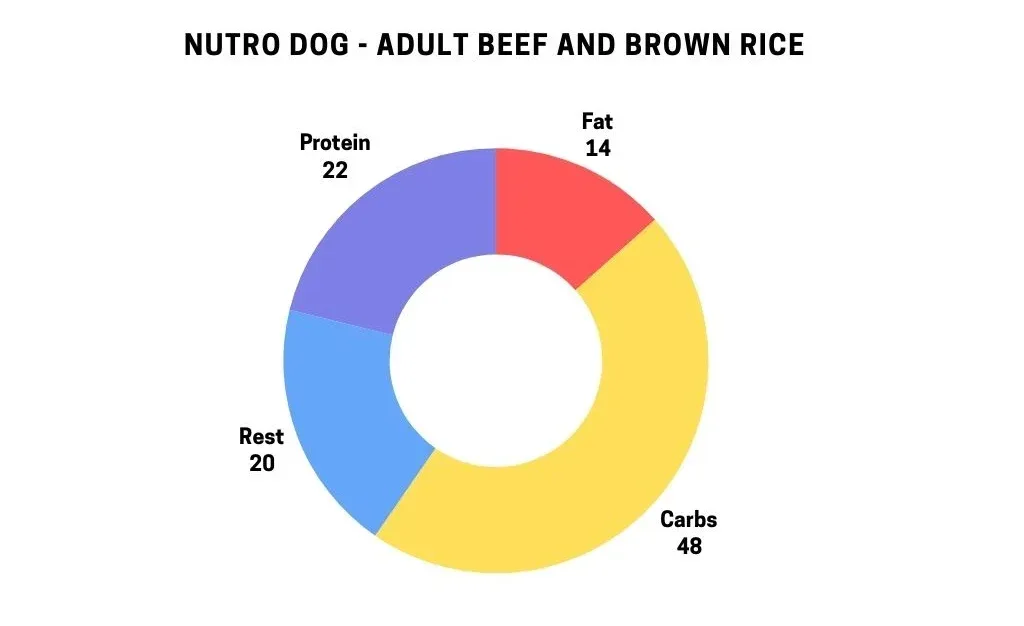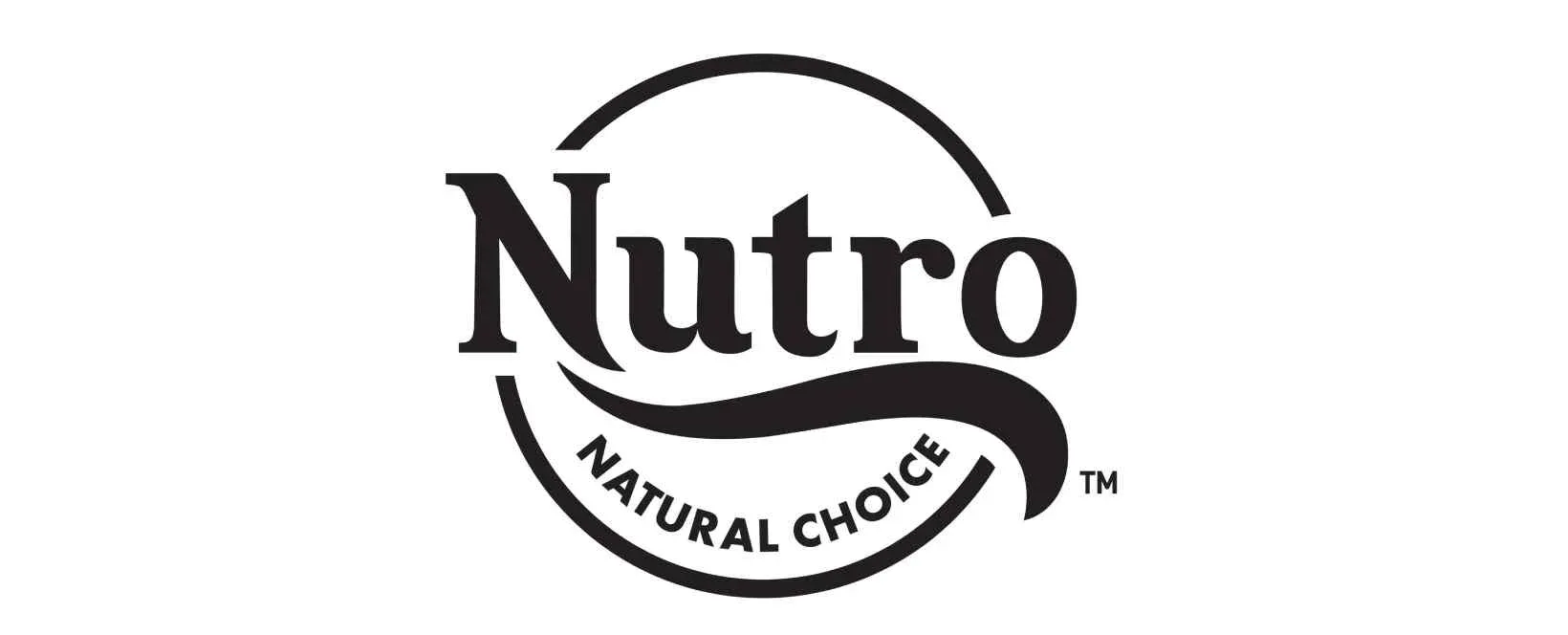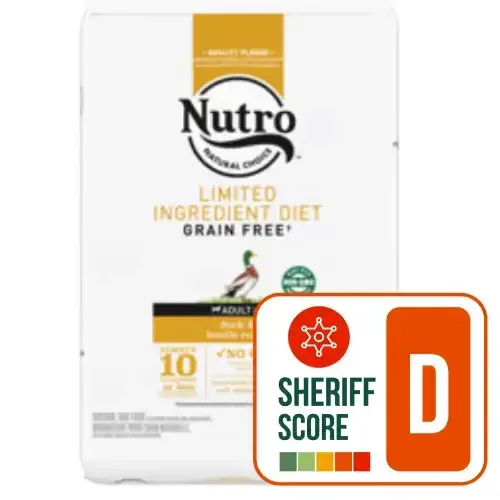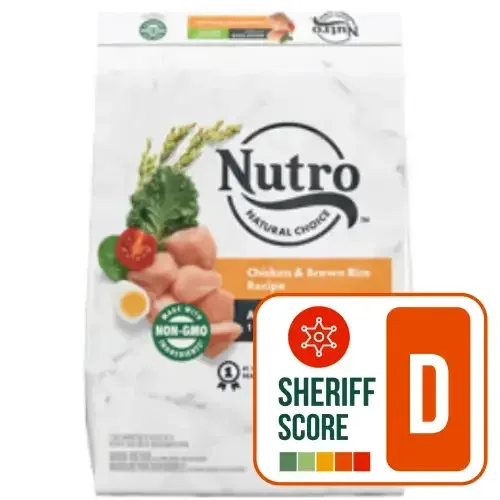Nutro is a brand of pet food belonging to the Mars PetCare group, which also owns Acana and Orijen. Their promise is that their diet is made up of healthy, natural ingredients to enhance the well-being of cats and dogs.
- No animal by-products
- Animal-based protein sources are clearly identifiable
- Low-quality animal protein (by-products)
- Can be protein-deficient for some dogs
- Carbohydrate levels are high
- We do not know the ash, calcium and phosporus content
Nutro – Adult Beef & Brown Rice – Analysis
Let’s now dive deeper into the puppy recipe characteristic of what the Nutro brand produces. This evaluation is based on the 23 criteria of the “Sheriff Score”.

| Criteria | Evaluation | Comments |
|---|---|---|
| Carbohydrate Content | 🔴🔴 Very High | At 49.5%, the carbohydrate content is excessively high and mainly from poor sources with high glycemic indices, posing risks of obesity and diabetes. Reduction to below 30% from lower GI sources is recommended. |
| Protein Content | 🔴 Low | Containing only 22% protein, this formulation falls short of supporting optimal muscle and body maintenance. The inclusion of high-quality animal proteins should be increased to at least 30%. |
| Protein-Calorie Ratio | 🔴 Low | The ratio of 60.11 indicates a suboptimal level of protein relative to calorie content, which does not support lean muscle maintenance effectively. |
| Protein-Phosphorus Ratio | ❓ Non-specified | Absence of data hampers the evaluation of protein quality and its impact on renal and bone health, which is critical for dietary balance. |
| Fat Content | 🟢🟢 Excellent | The 14% fat content is appropriate, supporting healthy skin, coat, and energy levels. However, the quality and source of fats should be verified to ensure they are from high-quality animal sources. |
| Ash Content | 🔴 To Monitor | The lack of detailed ash content data is concerning; low-quality ingredients may increase mineral imbalances affecting kidney and overall health. |
| Mineral Scoring | 🟠 Average | The use of inorganic minerals, likely due to cost considerations, reduces bioavailability. Transition to chelated minerals is advisable for better absorption and health outcomes. |
| Fiber Content | 🟠 Average | Fiber level at 4.5% is reasonable but optimizing with specific fibrous ingredients could enhance digestive health and fecal quality. |
| Moisture Content | 🟢🟢 Excellent | Ideal moisture content aids in hydration and digestion, a positive aspect of this food. |
| Calcium Content | ❓ Non-specified | Critical data on calcium is missing, which is essential for evaluating the support for bone health and growth in dogs. |
| Phosphorus Content | ❓ Non-specified | Without phosphorus levels, it’s difficult to assess the risk to kidney function and bone health, underscoring the need for transparency. |
| High Glycemic Index Ingredients | 🟢 Good | Absence of high GI ingredients among the top components is beneficial, yet the overall high carbohydrate content remains a concern. |
| Animal vs. Vegetable Protein Content | 🟢 Good | A favorable proportion of animal proteins is noted, but the exact sources and quality need clarification to ensure they meet high standards. |
| Quality of Animal Proteins | 🟠 Average | Protein quality is deemed average, possibly including lower-grade meats or by-products. Improvement with named, high-quality meats is necessary. |
| Preservatives | 🟢 Good | The use of natural preservatives is a positive feature, promoting safety and health over chemical alternatives. |
| Known Manufacturing Location | ❓ Hard to find | The lack of clear information about the manufacturing location raises concerns about quality standards and control practices. |
| Cooking Method | ❓ Non-specified | Non-disclosure of cooking methods could imply potential nutrient degradation; specifying low-temperature cooking could enhance nutritional integrity. |
| Quality and Transparency of Fats | 🟢 Good | The use of named animal fat sources like chicken or duck fat is commendable, supporting energy needs and cell structure effectively. |
| Calcium/Phosphorus Ratio | ❓ Non-specified | The absence of this ratio is a significant oversight, crucial for assessing the dietary support for bone health. |
| Omega 6/Omega 3 Ratio | 🔴🔴 Very Unbalanced | The high ratio of 10:1 promotes inflammation. Adjusting this balance closer to 5:1 or even 3:1 would significantly improve health outcomes. |
| Transparency | 🟠 Average | Moderate transparency efforts are noted, but greater clarity on ingredient sources, quantities, and manufacturing details would enhance trust. |
| Recipes Developed by a Veterinarian | ❓ Non-specified | Lack of information on veterinary involvement in formulation limits confidence in the nutritional appropriateness of the food. |
Positive Aspects:
- Moisture and Fat Content: 14% is generally an ideal balance for supporting a healthy coat, skin, and providing sufficient energy. The moisture content may indicate that the cooking process is not too destructive to nutrients and is perhaps at reasonable temperatures.
- Quality Choices: Using natural preservatives and named animal fats like chicken or duck is preferable to plant-based sources. Nutro has also opted for natural preservatives.
- Rich in Animal Proteins: The proportion of animal proteins is significantly higher than that of plant proteins. Animal proteins, superior to plant proteins in amino acid content, are essential for muscle development and overall vitality.
Areas for Improvement:
- High Carbohydrate Levels: Woah, the carb content is sky-high at 49.5%! Predominantly sourced from fast-acting sugars. We really need to bring that down to below 20% with lower GI alternatives like sweet potatoes, aligning better with canine needs and staving off obesity and diabetes risks. 🥔
- Protein Deficiency: Just 22% protein? That’s not enough! Dogs need robust support for growth and tissue repair. Boosting this with top-notch animal proteins would really kick the nutritional value up a notch.
- Need for Greater Transparency: Where’s the detailed info on nutrients? 🧐 Missing data on key elements like calcium and phosphorus, plus how they cook this stuff, really makes you wonder about the overall formulation. Transparency would help us all, especially for dogs on special diets!
- Mineral Bioavailability Issues: Using cheap inorganic minerals saves pennies but costs in health. Switching to chelated forms would seriously improve absorption, making every bite count for more in terms of health benefits.
- Imbalance in Omega Fatty Acid Ratios: The current omega 6 to omega 3 ratio is like inviting inflammation rather than fighting it—exactly what we don’t want! Let’s aim for a 5:1 ratio, or hey, even 3:1 would be perfect for keeping things cool and calm in the inflammation department.
Our honest opinion
The brand is trying, but the compositions are very similar to those in the petfood industry. That is not enough. These are typical recipes that could lead to weight gain in dogs, and we’re told that these kibbles must be delicious because dogs, like humans, can become addicted to carbohydrates. Due to the lack of precision in the analytical constituents, it is impossible to determine the true quality of animal proteins. So we can’t give you a very high score. because the brand doesn’t provide enough analytical information about their kibbles.





